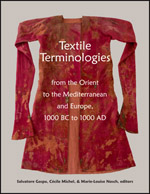Center, Textile Research

Textile Terminologies from the Orient to the Mediterranean and Europe, 1000 BC to 1000 AD
Date of this Version
2017
Document Type
Article
Citation
In Textile Terminologies from the Orient to the Mediterranean and Europe, 1000 BC to 1000 AD, ed. Salvatore Gaspa, Cécile Michel, & Marie-Louise Nosch (Lincoln, NE: Zea Books, 2017), pp. 210-227
doi:10.13014/K2319T2K
Abstract
Despite numerous recent studies of Italic textiles and textile production etc., no systematic study has so far been attempted regarding the textile terminology of Italic languages besides Latin. The present study seeks to remedy this, making a first step into the textile terminology of Sabellic languages, predominantly Oscan and Umbrian. There are two types of sources for Sabellic textile terminology: inscriptions and glosses in Greek and Latin literature. Both are, however, fraught with uncertainties. The glosses, as for example seen in the case of Etruscan, may have been misunderstood or misinterpreted and should be treated with due caution, and there is considerable debate on many of the epigraphically attested terms and significant doubt about their precise interpretation. Glosses are especially problematic, since they have been transmitted to us through a succession of manuscripts. As noted by Clackson, it is only through epigraphy that we can access the texts, and therefore the terms themselves, directly. Sometimes, however, the glosses are indeed correct, making their investigation important. The extant Sabellic corpus, although minuscule compared to Latin, is nevertheless linguistically invaluable and offers complementary evidence of the Indo-European and Italic textile lexicon, although many aspects of the various Sabellic languages are notoriously difficult to interpret and remain a matter of debate. The present contribution does not claim to endorse the interpretation of the most doubtful cases, but includes them in order to provide an overview of Sabellic terms that have been suggested by scholars as belonging to the domain of textiles.
Included in
Ancient History, Greek and Roman through Late Antiquity Commons, Art and Materials Conservation Commons, Classical Archaeology and Art History Commons, Classical Literature and Philology Commons, Fiber, Textile, and Weaving Arts Commons, Indo-European Linguistics and Philology Commons, Jewish Studies Commons, Museum Studies Commons, Near Eastern Languages and Societies Commons, Other History of Art, Architecture, and Archaeology Commons


Comments
Copyright © 2017 Salvatore Gaspa, Cécile Michel, & Marie-Louise Nosch. Photographs copyright as noted.